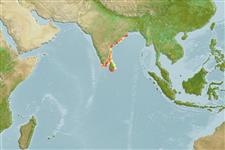Common names from other countries
>
Scombriformes (Mackerels) >
Trichiuridae (Cutlassfishes) > Trichiurinae
Etymology: Lepturacanthus: Greek, leptos = thin + Greek, oura = tail + Greek, akantha = thorn (Ref. 45335).
Environment: milieu / climate zone / depth range / distribution range
Ecologia
marinhas; estuarina bentopelágico; intervalo de profundidade 0 - 80 m (Ref. 6181). Tropical; 21°N - 5°N, 76°E - 87°E (Ref. 6181)
Indian Ocean: Hooghly estuaries to Gulf of Mannar in the east coast of India.
Tamanho / Peso / Idade
Maturity: Lm ? range ? - ? cm
Max length : 92.0 cm TL macho/indeterminado; (Ref. 6181); common length : 40.0 cm TL macho/indeterminado; (Ref. 6181)
Espinhos dorsais (total) : 3; Raios dorsais moles (total) : 121 - 131; Espinhos anais: 2; Raios anais moles: 74 - 84. Body extremely elongate, compressed and tapering to a point. Anal fin reduced to a long spine and 74 - 84 smaller spinules; pelvic and caudal fins absent. Lateral line running nearer the ventral contour than the dorsal contour of the body. Body color steely blue with metallic reflections in fresh specimens, becoming silvery gray after death.
Benthopelagic or pelagic in estuaries and coastal waters. Feeds on a wide variety of small fishes and crustaceans chiefly on prawns, young clupeoids, Harpodon nehereus and Trichiurus spp. in Hooghly estuaries, India. Caught mainly with bag nets in estuaries, with shore seines and boat seines in inshore waters, and with trawls in off-shore waters. Marketed fresh as well as dried salted.
Life cycle and mating behavior
Maturities | Reprodução | Spawnings | Egg(s) | Fecundities | Larvas
Nakamura, I. and N.V. Parin, 1993. FAO Species Catalogue. Vol. 15. Snake mackerels and cutlassfishes of the world (families Gempylidae and Trichiuridae). An annotated and illustrated catalogue of the snake mackerels, snoeks, escolars, gemfishes, sackfishes, domine, oilfish, cutlassfishes,. scabbardfishes, hairtails, and frostfishes known to date. FAO Fish. Synop. 125(15):136 p. (Ref. 6181)
Categoria na Lista Vermelha da IUCN (Ref. 130435)
CITES (Ref. 128078)
Not Evaluated
Ameaça para o homem
Harmless
Utilização humana
Pescarias: pouco comercial
Ferramentas
Relatórios especiais
Descarregue XML
Fontes da internet
Estimates based on models
Phylogenetic diversity index (Ref.
82804): PD
50 = 0.6250 [Uniqueness, from 0.5 = low to 2.0 = high].
Bayesian length-weight: a=0.00191 (0.00078 - 0.00466), b=3.11 (2.90 - 3.32), in cm Total Length, based on LWR estimates for this (Sub)family-body shape (Ref.
93245).
Nível Trófico (Ref.
69278): 4.1 ±0.71 se; based on food items.
Resiliência (Ref.
120179): Médio, tempo mínimo de duplicação da população 1,4 - 4,4 anos (Preliminary K or Fecundity.).
Fishing Vulnerability (Ref.
59153): High vulnerability (57 of 100).
